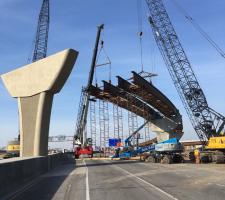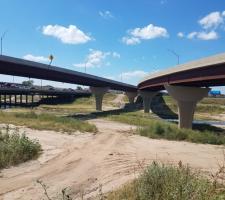
Around 10% of highway congestion in the US results from delays in workzones, leading to an estimated annual loss of $700 million in fuel costs alone. The lack of accessible real-time traffic information to help motorists minimise their inconvenience – particularly at peak times - is a major contributor.
One solution gaining momentum is the ITS-based smart workzone (SWZ). Wichita, the largest city in the US state of Kansas, has recently implemented three of these.
The latest has been deployed in conjunction with the first phase of the $116 million I-235/US-54 interchange improvement scheme that was originally due for completion in June. Drivers have, however, been benefiting from a series of early-finished lanes and ramp improvements since December 2018. (Remaining works, some held back for better weather, are due for completion by the original date).
Parts of the interchange were over 50 years old, while interstate traffic levels have been rising steadily, contributing to a current volume of over 130,000 vehicles passing through it every day.
Merge points
The scheme has removed potentially dangerous merge points - one of these against conflicting traffic within 100m (300 yards), now extended to 1.6km (one mile). It has also installed dedicated directional ramps, making the interchange easier to navigate – not least by avoiding the need for drivers to make sharply curved exits at speeds well below highway norms. The SWZ concept is being strongly encouraged by the US
In Wichita, the aim was to achieve higher diversion rates by giving drivers information that was not only accurate but practically actionable at critical points in advance of the works – which ultimately saved roadway users delay costs, not least for unfamiliar drivers.
Preliminary studies had indicated that, to keep the impact of the construction works to a minimum, peak diversion rates would need to be as high as 40% - well above the 15%-20% levels that are typically seen in construction zones. Kansas Department of Transportation (KDoT) then brought in Missouri-based transportation consultant TranSystems to design a solution that would achieve this level and so minimise problems.
Intersecting highways
The result was a subset of SWZ-based elements designed to deal with the heaviest traffic movements between the intersecting highways and to take pressure off heavily used interchanges. Key components included portable cameras and traffic sensors, to identify issues arising from incidents and congestion; and portable dynamic message signs (DMS), to enable the automatic posting to motorists of estimated drive-through times and available diversions.
The portable DMS complemented the large roadside boards that were already in place as part of the city’s established WICHway travel information service, which operates from the regional emergency control centre.
According to data collected during construction, as much as 50% of traffic was proving ready to divert once delays of seven minutes or more in commuting times were indicated for established commuter routes – taking pressure off severely impacted junctions. (KDoT was then able to adopt seven minutes as the ‘magic number’ for its routing calculations).
But one deployment went better still. Preliminary studies had indicated that, on one stretch of a typical commute, the Maple Street local artery would be the optimal alternative to using the US-54. In response, KDoT, working with the city of Wichita, decided temporarily to retime its traffic signals to make the phasing more welcoming to peak-hour users, with a supporting array of sensors, cameras and signs to supplement existing installations. The results exceeded the team’s expectations, with diversion rates rising to as high as 70% while some US-54 lane closures were in force.
Integral element
KDoT SWZ coordinator Garry Olson reported: “The design kept traffic moving safely, both through the construction site and along the alternative routes. We are encouraged by the results and look forward to maximising our use of this technology in future projects.”
The system is now an integral element in the regional WICHway traffic information service, owned and operated by KDoT in cooperation with regional partners. At the same time, it is flexible enough to mean that full-scale deployment will not always be necessary.
KDoT spokesperson Tom Hein told ITS International: “We now have enough WICHway infrastructure in the area, plus equipment such as the portable DMS, to make us feel sure that we can make the journey less stressful for drivers by using some, but not all, SWZ tactics.”
Engstrom added: “We are still calculating the precise benefit/cost ratio for the zone, but preliminary indications are calculating at approximately 10:1.”
DMS makes major contribution
Two of Wichita’s highways - the US-54 and the I-135 – were the focus of a detailed 2017 cost-benefit study on ITS which was carried out for Kansas DoT by TranSystems. This compares the results of a 2009 pre-deployment exercise, aimed at identifying the best locations for the future installation of ITS equipment along the two routes, with later data derived from devices that were actually deployed.
The costs are averaged between individual ITS projects and annual operations and maintenance expenditures. The total hours saved due to advanced traveller information system (ATIS) deployments come out at 217.17 hours on US-54 and 170.67 hours on I-135. The total benefit estimated from displaying comparative travel times on US-54 is $1,672,430 and on I-135 is $1,314,327. This indicates a benefit-to-cost ratio of 12.18 – with annual benefits of $14,351,501 against annual costs of $1,178,766.
The analysis highlights DMS as making a major contribution to the savings, and suggests that increased deployment to display relevant information on travel times, congestion and incidents to road users could significantly increase their usefulness. At the same time, it points out that devices such as CCTV and traffic detectors generate the information needed for display on DMS; and for identification and verification in traffic incident management, “but, in themselves, do not necessarily have a readily quantifiable benefit” (see table). For future exercises, it suggests the tracking and averaging of user-delay costs per incident, in order to generate more accurate estimates of the effects on road capacity as well as on road users. Again, increased usage of DMS displaying relevant information regarding travel times, congestion, and incidents to road users could provide significant gains in the benefits achieved through their deployment.
The analysis was carried out using the latest version of the FHWA’s Tool for Operations Benefit/Cost (TOPS-BC V1.2).







